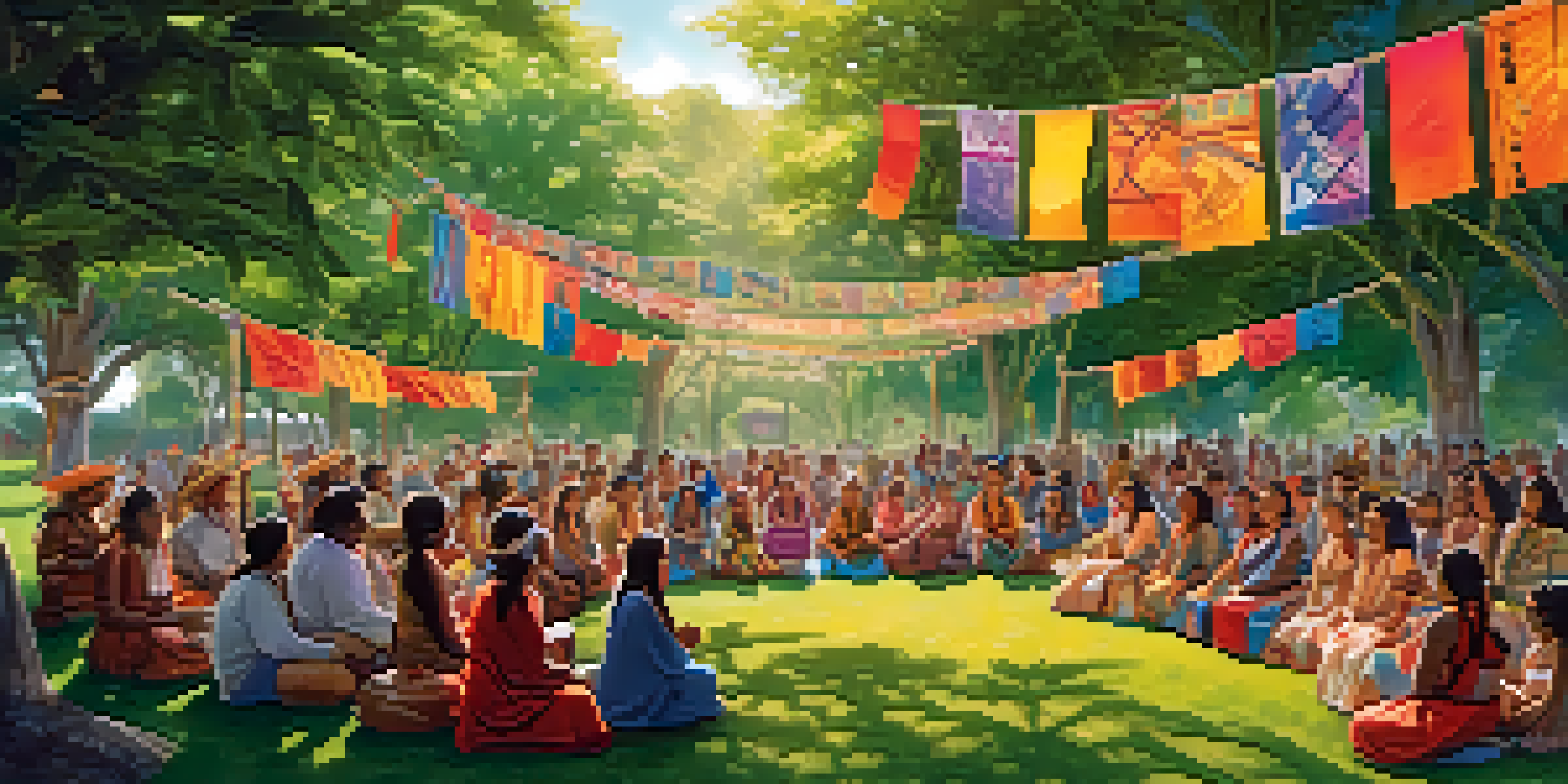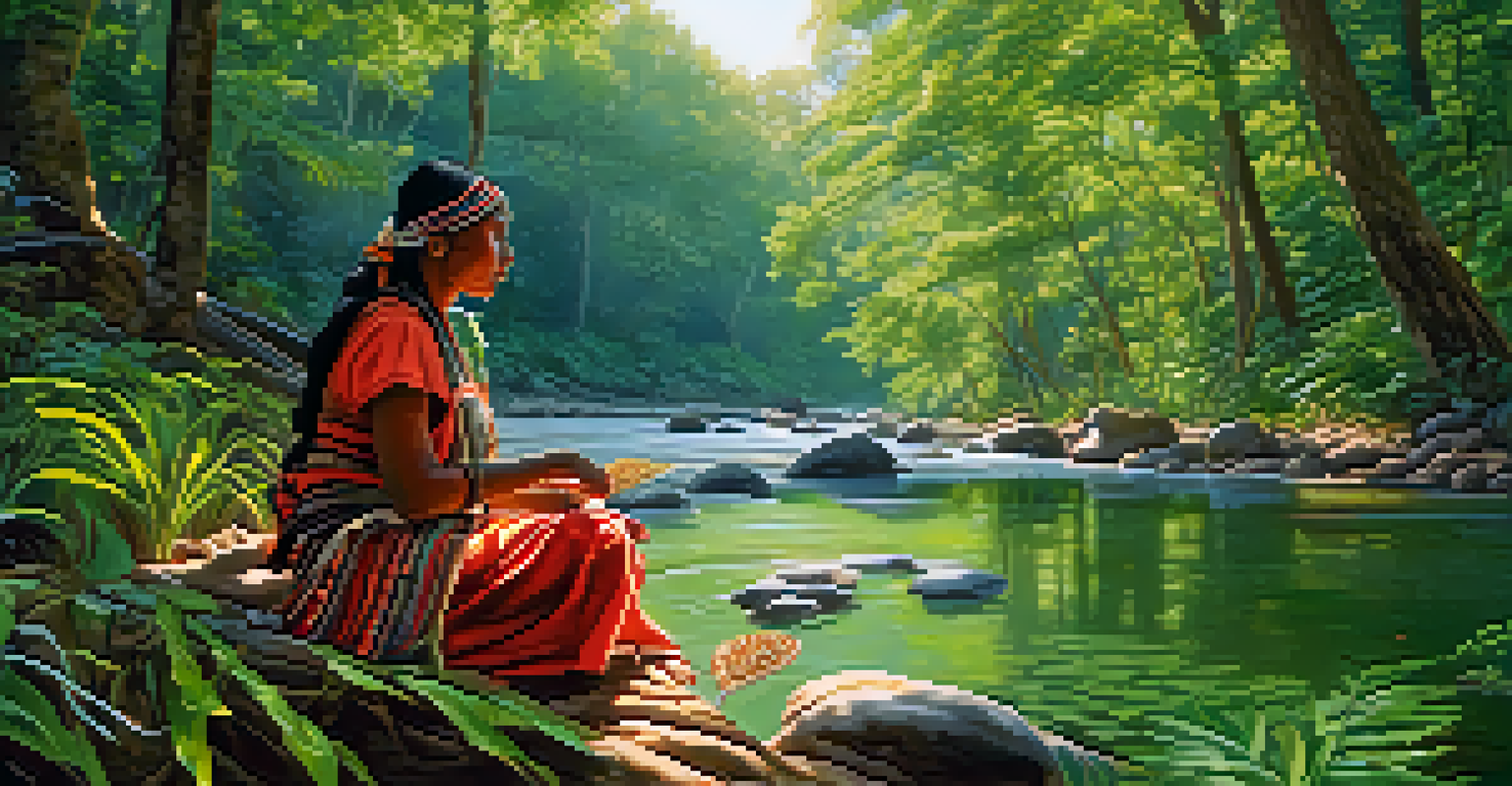Indigenous Legends: Storytelling Experiences Across India

The Art of Storytelling in Indigenous Cultures
Storytelling is a cornerstone of Indigenous cultures across India, serving as a means to pass down history, traditions, and values. These narratives, often filled with rich characters and moral lessons, are more than mere entertainment; they are a vital expression of cultural identity. Each story reflects the unique experiences of the community, offering insights into their beliefs and ways of life.
Indigenous peoples have a deep connection to their land and their stories are a reflection of that bond.
For instance, the oral traditions of the Santhal tribe in Jharkhand include tales of their ancestors and the spirit world, which help maintain a connection to their past. This practice not only preserves history but also fosters a sense of belonging among community members. In this way, storytelling becomes a bridge linking generations together, ensuring the survival of cultural heritage.
Moreover, these tales often take on various forms, including songs, dance, and rituals, making storytelling a multi-faceted experience. This dynamic form of expression not only captivates listeners but also invites them to participate, creating a communal atmosphere. Such engagement enhances the storytelling experience, making it a cherished event within Indigenous communities.
Regional Diversity in Indigenous Legends
India's vast landscape is home to a rich diversity of Indigenous tribes, each with its unique legends and storytelling traditions. From the North to the South, East to West, each region boasts tales that reflect the local culture, geography, and societal values. For example, the folklore of the Bhil community in Madhya Pradesh often features themes of nature and animals, illustrating their close relationship with the environment.

In contrast, the myths of the Khasi tribe in Meghalaya delve into the creation of the world and the significance of their matrilineal society. These stories often incorporate elements of local flora and fauna, creating a vivid tapestry of life that resonates deeply with listeners. Through these narratives, communities express their identities and navigate contemporary challenges while drawing from their historical roots.
Storytelling Preserves Cultural Identity
Indigenous storytelling is essential for passing down history, traditions, and values, fostering a strong sense of belonging within communities.
The blending of these regional tales can lead to fascinating exchanges between communities, enriching the storytelling experience. Festivals often serve as platforms where different tribes share their legends, fostering understanding and appreciation of each other's cultures. This cross-pollination of stories emphasizes the importance of preserving Indigenous narratives in an increasingly globalized world.
The Role of Nature in Indigenous Storytelling
Nature plays a pivotal role in Indigenous storytelling, often serving as both a backdrop and a central character in the narratives. Many legends depict the relationship between humans and the natural world, highlighting the significance of elements like rivers, mountains, and animals. For instance, the stories of the Gonds in central India frequently illustrate how the forest is not just a resource but a living entity deserving respect.
Stories are the most powerful way to put ideas into the world today.
Tales of creation often involve natural phenomena, linking the community's existence to their environment. These narratives teach younger generations about sustainability and the importance of coexisting with nature. By emphasizing these connections, storytelling becomes a powerful tool for environmental stewardship within Indigenous cultures.
Furthermore, the cyclical nature of many Indigenous stories mirrors the cycles found in nature, reinforcing the concept of interdependence. As listeners engage with these tales, they are reminded of their role within the ecosystem. This connection fosters a sense of responsibility towards the environment, encouraging stewardship and conservation efforts among Indigenous communities.
Indigenous Legends: Lessons for Modern Society
The wisdom embedded in Indigenous legends holds valuable lessons for modern society, particularly in addressing current social and environmental issues. Many stories emphasize themes of community, cooperation, and respect for nature, offering a counter-narrative to individualism often seen in contemporary culture. For example, tales that focus on collective action can inspire community-driven solutions to local challenges.
Additionally, the moral lessons found in these legends often resonate with universal human experiences, making them relevant across generations. They remind us of the importance of empathy, resilience, and understanding in navigating life's complexities. By learning from these narratives, people can cultivate a deeper appreciation for diverse perspectives and foster a more inclusive society.
Nature's Role in Indigenous Narratives
Many Indigenous legends emphasize the relationship between humans and nature, teaching lessons about sustainability and environmental stewardship.
Moreover, engaging with Indigenous legends can encourage a shift in mindset towards sustainability and ecological balance. As modern society grapples with climate change and resource depletion, the teachings of Indigenous cultures can guide us in developing more harmonious relationships with our environment. This highlights the need for a dialogue between Indigenous wisdom and contemporary practices.
Preserving Indigenous Storytelling Traditions
As globalization continues to influence cultures worldwide, preserving Indigenous storytelling traditions has become increasingly important. Many communities are actively working to safeguard their narratives through documentation, education, and revitalization efforts. By recording stories in written form or through digital media, they ensure that future generations can access their rich cultural heritage.
Moreover, community workshops and storytelling festivals are becoming popular avenues for sharing these legends with broader audiences. These events not only celebrate Indigenous culture but also promote intergenerational dialogue, allowing elders to pass down stories to younger members. This process strengthens community bonds and fosters a sense of pride in cultural identity.
Partnerships with educational institutions and cultural organizations also play a crucial role in preserving these traditions. By integrating Indigenous storytelling into school curriculums, educators can raise awareness and appreciation for these rich narratives among students. This approach not only benefits Indigenous communities but also enriches the cultural fabric of society as a whole.
The Impact of Technology on Indigenous Storytelling
Technology has transformed many aspects of storytelling, including how Indigenous legends are shared and preserved. Digital platforms provide new opportunities for Indigenous communities to showcase their narratives to a global audience. Through podcasts, social media, and online videos, these stories can reach far beyond their geographical boundaries, promoting cultural exchange and understanding.
However, while technology offers new avenues for storytelling, it also presents challenges related to cultural appropriation and authenticity. As Indigenous stories gain popularity online, it becomes essential to ensure that they are shared respectfully and accurately. Communities are increasingly advocating for their narratives to be represented by their own voices, rather than being appropriated by outsiders.
Technology and Tradition in Harmony
While technology offers new platforms for sharing Indigenous stories, it is crucial to maintain authenticity and respect for cultural narratives.
The balance between embracing technology and preserving authenticity is crucial for the future of Indigenous storytelling. By leveraging digital tools responsibly, communities can maintain control over their narratives while engaging with wider audiences. This ensures that the essence of their stories remains intact while adapting to the changing landscape of communication.
Celebrating Indigenous Legends: Festivals and Events
Festivals and events dedicated to Indigenous storytelling provide vibrant platforms for celebrating and sharing cultural heritage. These gatherings often include traditional music, dance, and art, creating an immersive experience that captivates attendees. For example, the Hornbill Festival in Nagaland showcases the diverse cultural heritage of various tribes, with storytelling as a central feature.
Through these events, Indigenous communities can not only share their legends but also foster connections with outsiders. Attendees have the opportunity to engage with storytellers, participate in workshops, and gain a deeper understanding of Indigenous cultures. This interaction promotes respect and appreciation, breaking down barriers between different communities.

Moreover, storytelling festivals can serve as a means of economic empowerment for Indigenous artisans and performers. By attracting tourists and visitors, these events create opportunities for local economies, allowing communities to thrive while preserving their unique cultural identity. Celebrating Indigenous legends in this way ensures that these narratives continue to be cherished by future generations.